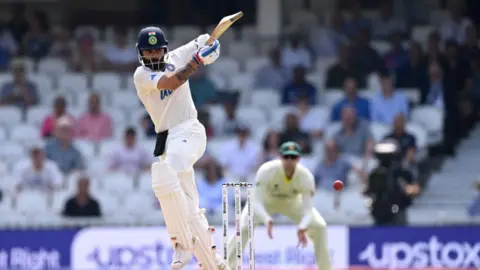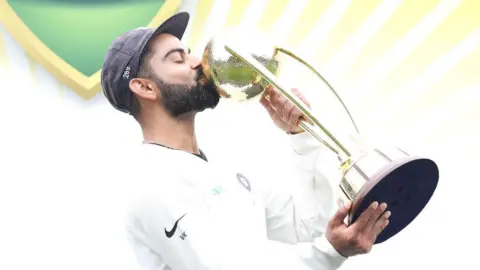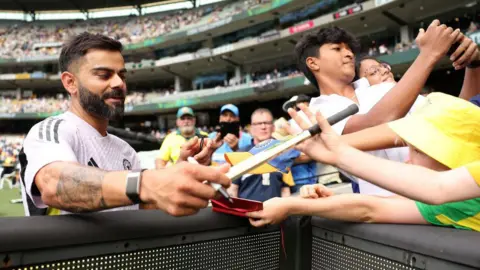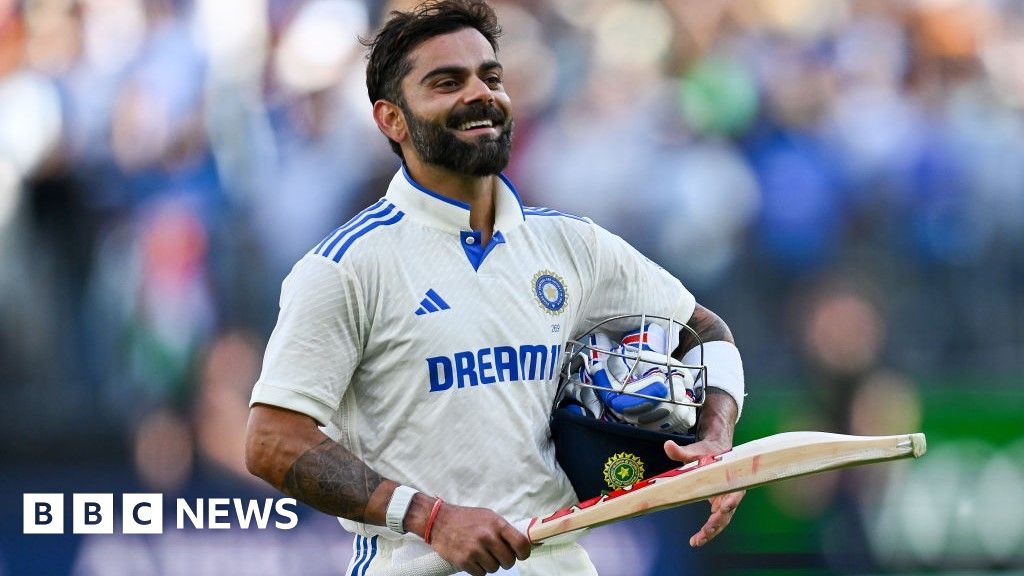Virat Kohli’s retirement from Tests has left Indian cricket beleaguered and the sporting world gasping in surprise.
Coming on the heels of captain Rohit Sharma quitting a few days earlier, it adds up to a double whammy for India who embark on a tough tour of England for a five-Test series come June without their two most experienced batters.
Like Sharma, Kohli took to Instagram, where he commands more than 270 million followers, to make his retirement public.
“As I step away from this format, it’s not easy – but it feels right…” he explained to his disconsolate fans.
Tributes for Kohli have come in a deluge since: from fellow cricketers, past and present, old and young, and also legends from other disciplines like tennis ace Novak Djokovic and football star Harry Kane, which highlights the sweep and heft of Kohli’s global appeal.
Leading India to victory in the Under-19 World Cup in 2008, Kohli was fast tracked into international cricket by the then-chairman of selectors, former India captain Dilip Vengsarkar, against the judgement of others in the cricket establishment.
“Many in the Indian cricket board felt he was too young but he was scoring heavily in domestic cricket, and the hunger to succeed was palpable in him,” recalls Vengsarkar.
An example of Kohli’s obsessive passion for the sport comes imbued with poignancy. Kohli was playing his second Ranji Trophy match for Delhi. His father passed away suddenly with his team in a crisis. After the funeral, he went back and scored a battling 90.
 Getty Images
Getty ImagesVengsarkar’s approving eye earned Kohli an ODI debut in 2009. At 23, he was the youngest member of India’s 2011 ODI World Cup winning team under MS Dhoni. A few weeks later, he made his Test debut in the West Indies. Some months on, during the disastrous tour of Australia with his place under threat, Kohli made a gritty maiden century and never looked back. Within a couple of years he established himself as the pre-eminent batter of his generation.
Brash and provocative, without a benign muscle in his body, he was as volatile as potassium on water in his early years. He was unafraid to take on the most reputed opponents, often indulging in on-field fracases that sometimes earned him criticism.
Happily, this was not to become his defining identity in cricket. Prolific run-getting in dashing style across formats provided another more compelling dimension and was to take him to the pinnacle.
When his idol Sachin Tendulkar retired in 2013, Kohli, allying unbridled ambition with his abundant skills, grabbed the baton hungrily and went on to sketch one of the most stellar careers in cricket history.
He wielded the bat like a Jedi, with great skill and telling thrust to slay opponents, as it were. Coupled with his high-octane persona, his scintillating batting made him a cult hero whose very presence ensured blockbuster box-office returns everywhere he played.
Kohli always wore his passion on his sleeve. He was always demonstrative and dramatic on the field but over a period of time, misplaced angst was sublimated into a raging inner pursuit of excellence that took him to dizzying heights.
Marriage to film star Anushka Sharma made them the country’s foremost power couple, putting both under the glare of even more intense spotlight.
Metaphorically, Kohli’s outstanding exploits, especially in the first decade of his career, epitomised the emerging India of the 21st century: unabashedly, unrelentingly ambitious, discarding all past demons, willing to take on the best in the world.
His achievements across formats are monumental.
In ODIs, he is third in run aggregate behind Tendulkar and Kumar Sangakarra, but boasts the best average (57.88) among batters who have played more than 100 games. His ability to win ODI matches in the most daunting run chases is the stuff of folklore, many of his record 51 centuries coming in such pursuit.
 Getty Images
Getty ImagesIn T20s, his run aggregate and centuries don’t put him in the top five, but he’s immortalised himself with incredible knocks, notably 82 not out in an emotion-charged, pulsating match against arch-rivals Pakistan in the 2022 World Cup and a vital 76 in the 2024 final against South Africa, which helped India win the title.
He is also the highest run scorer in the history of the Indian Premier League.
At one point, Kohli averaged 50-plus in all three formats, making him the most productive and versatile batter of his era – way ahead of contemporaries Joe Root, Kane Williamson and Steve Smith. The four were locked in a fascinating, long-running race for batting supremacy.
When it appeared he would break all batting records, Kohli’s career took an inexplicable downturn. From the start of the pandemic, the flow of runs began to ebb and centuries became a trickle. In his pomp – between 2014 and 2019 – he had been unstoppable, at one time scoring six double centuries in just 18 months.
The drought of runs hit him most adversely in Test cricket where his average, from a high of 55-plus in 2019 slumped to the current 46.75. In this period, Kohli also lost the captaincy, though his stellar standing in international cricket remained untouched.
Kohli finishes his Test career with 9,230 runs, which puts him 19th overall in aggregate, and fourth among Indians behind Tendulkar, Rahul Dravid and Sunil Gavaskar, all of whom finished with a 50-plus average and more centuries. But to judge him only on this yardstick would diminish the massive impact he has had on this format .
As captain, Kohli easily hurdles over Gavaskar, Tendulkar and Dravid. In Test cricket, winning 40 of the 68 matches he led in, making him the fourth most successful in the format. In the Indian context, this assumes Himalayan proportions.
Former Australia captain Greg Chappell says that Kohli’s energy, grit, sense of purpose and aura was “transformative” for Indian cricket. Chappell marks him out as the most influential Indian captain, ahead of even Sourav Ganguly and M S Dhoni.
Former India captain and chief coach Ravi Shastri, who collaborated with Kohli for years, gives first-hand perspective.
“Kohli made India into a fighting unit, especially when playing overseas,” says Shastri.
 Getty Images
Getty ImagesThe lack of ICC and IPL titles according to Shastri, is misleading as an index to his captaincy ability.
“He always played to win, sought and nurtured fast bowlers to win overseas, demanded high intent and supreme fitness from all players, putting himself in the forefront, not as a backseat driver.”
For seven years when Kohli and Shastri collaborated, India were in the top three in ICC rankings in all formats almost continuously which is unprecedented.
The most cherished and significant triumph of this period came in 2018 when India beat Australia in its own backyard in a Test series for the first time ever.
Australia is where Kohli had launched himself into batting greatness, scoring 692 runs in four Tests in 2014-15. In 2018, he contributed as captain and batter to break an hitherto unassailable psychological barrier. In 2020 touring Australia, Kohli played only one match (which was lost) returning home for the birth of his child. But India, having overcome the mental barrier two years earlier, went on to win the rubber in a melodramatic see-saw series.
Australia was Kohli’s happy hunting ground and his last visit Down Under in late 2024 grabbed worldwide attention. He began with a roar, hitting a century in the first test at Perth. But his form fizzled out alarmingly and made only 190 runs in the five Tests.
How much this contributed to his decision to retire is moot. Advancing years, the dislike of being constantly under harsh scrutiny, wanting to be close to his young family and behind the scene shenanigans that abound in Indian cricket have doubtless played a part too.
Kohli ends his retirement post on Instagram enigmatically.
“I’ll always look back at my Test career with a smile. #269 signing off,” he wrote.
The greatest ambassador for the five-day format in the last decade and a half had moved into the sunset.
Follow BBC News India on Instagram, YouTube, Twitter and Facebook.


